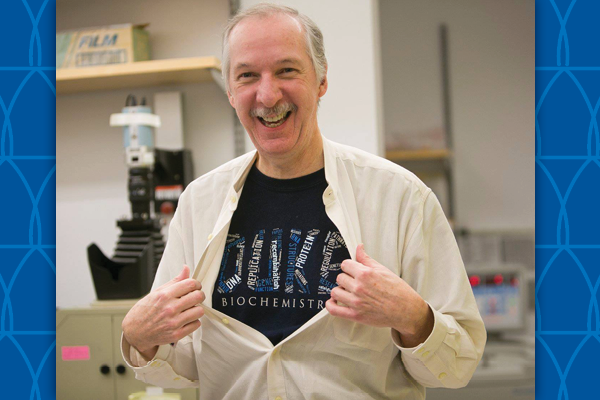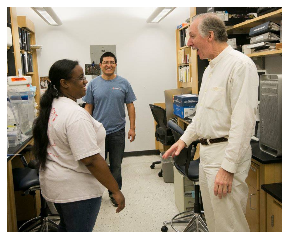
Richard G. Brennan, PhD, James B. Duke Distinguished Professor of Biochemistry, can count many successes during his 13 years as chair of the Duke Department of Biochemistry, including celebrating two Nobel Laureates from the department, as well as playing a pivotal role in bringing the vital technology of cryogenic electron microscopy (Cryo-EM) to Duke.
But, looking back, he feels the most satisfaction from the success and promotion of the many talented junior faculty that were recruited during his tenure. “We tried to make this a welcoming department, with an open-door policy,” he said.
Brennan has practiced intentional mentoring, in which he met with each assistant professor at least once a month. “These are really smart, talented people, but they start out with an empty lab,” he said. “They have to build it up from scratch.”
Brennan also set new faculty up with a wide variety of other mentors. “The first day they walk in, they have a mentoring committee, so they get another set of opinions compared to mine,” he said.
Huanghe Yang, PhD, associate professor of biochemistry, said that Brennan’s intentional mentoring strategy was instrumental for him as a junior faculty member. “About a year after I arrived at Duke, my research center was dissolved,” Yang said. “Dick’s unwavering support helped me navigate that challenging period and smoothly transition back to the department. Over the years, his advice has been invaluable, guiding me not only in managing a research team but also in excelling in my research.”

Brennan said he loves the team environment at Duke. “It’s a very open, collaborative university, and that’s been a really great thing,” he said. “Our students have also made me stay. They’re really bright, and it’s fun to interact with them.”
As a significant part of this atmosphere, Dr. Brennan has also enjoyed a wonderful collaboration with John Perfect, MD, James B. Duke Distinguished Professor of Medicine and chief of the Division of Infectious Diseases, that has allowed this team to make significant progress in understanding the fundamentals of pathogenic fungal survival in the human host with the goal of abrogating fungal disease.
Under Brennan’s guidance, the department created an Equity, Diversity, and Inclusion (EDI) Committee in 2013, one of the first departments in the School of Medicine to do so.
Michael Boyce, PhD, an associate professor of biochemistry, got involved with the department’s EDI efforts early on. “Dick truly cares about all members of the department and is an attentive, equity-minded, and skillful mentor of students, postdocs, staff and junior faculty alike,” he said. “I’ve been grateful for his advice and support throughout my time at Duke. I’m very glad that we still have him in the biochemistry community!”
In 2017, Duke was just the second university in the United States to install a high-resolution Cryo-EM instrument, in large part because of Brennan’s insistence. He calls the push to get it done a collaborative effort between him; Raphael Valdivia, PhD, who was then vice dean for basic science and is now chair of the Department of Integrative Immunobiology; and Nobel Prize winner Robert Lefkowitz, MD.
Brennan also wants to give a great deal of thanks to Mark Walters, PhD, and Nan Jokerst, PhD, of the Pratt School of Engineering and Mario J. Borgnia, PhD of the NIEHS, for their help in this endeavor, as well as to Executive Vice President for Health Affairs and School of Medicine Dean Mary Klotman, MD, and Vice Dean for Basic Science Colin Duckett, PhD, for their help in maintaining and expanding the capabilities of this facility. Today, the Cryo-EM is heavily used, running nearly 24 hours a day and playing an important role in basic science discoveries and vaccine design.
Brennan’s research has centered on transcription and post-transcriptional regulation. His lab determined the “first structure” of key proteins, offering atomic insights into DNA recognition mechanisms and transcription regulation. Notably, the Brennan lab pioneered the understanding of multidrug resistance in bacteria, describing structures of two key proteins that are involved (QacR and BmrR) and defining mechanisms of multidrug binding.
His scientific achievements have been recognized through election as Fellow of the American Academy of Microbiology and a Fellow of the American Association for the Advancement of Science.
When Brennan was recruited to Duke, he was looking to move to a new institution, but he wasn’t really looking for a chair’s position. But when a Duke scientist contacted him to ask him to write a review article, Brennan sent along his CV as well as that of his partner, Maria Schumacher, PhD, asking if biochemistry was looking for two new faculty members.
To Brennan’s surprise, he received a reply asking him if he’d consider applying for the position of chair. “After that it went pretty fast,” he said.
Brennan wrapped up his successful run as chair on September 2, 2024.
Moving forward, he is “rebalancing” — finishing up grant-funded research and perhaps seeking funding for an additional project. And he is thinking about the right time to wind things down. “People should retire sometime and turn over the reins,” Brennan said. “But right now I’m focusing on my science.”